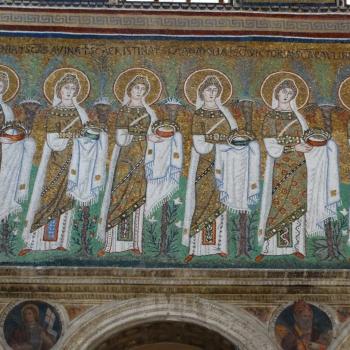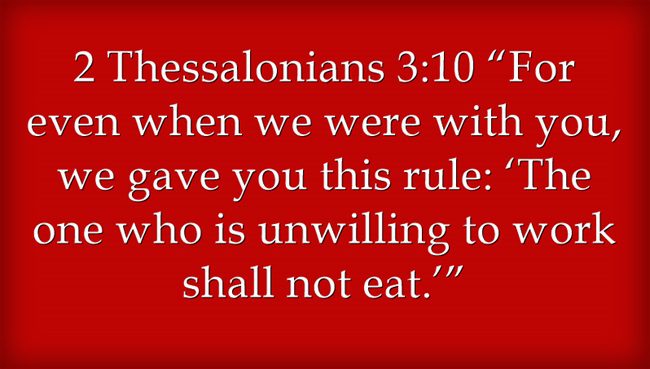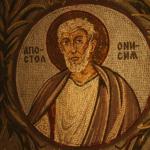
Communion, pt. 10 | Discussion
For more on Communion in the Early Church from the Archives CLICK
East and West
The Eastern rite seems to offer a more adequate place for the work of the Spirit than the West, at least in the early days. As previously noted:
“The East anticipated the medieval Western doctrine of the real presence by many hundreds of years. This change is brought about by the Holy Spirit . . . the fully-developed theology of the Third Person.”[1]
Dom Gregory Dix states the church in the region of Syria invokes the Spirit in the consecration in the first three centuries. Syria is the first to do so.[2]
Hugh Wybrew says Cyril is first to develop the epiklesis, the Spirit changing the elements, which is not followed by the West.[3] Dix says that from this time on (fourth century), the East sees the Spirit “energising in the eucharist.”[4] Wybrew summarizes:
“Among the issues hotly debated between Orthodox and Latin Catholics was the precise moment of consecration in the Eucharist. The Western tradition had for centuries associated it with the narrative, and later more narrowly with the precise words, of the institution. The Eastern had come more and more to link it with the invocation of the Holy Spirit.”[5]
Charles Pinnock says the West focuses on transubstantiation, but the East focuses on the descent of the Holy Spirit.
“In the [Eastern] prayer of invocation, clergy stand before the altar with arms outstretched, imploring the Spirit to descend on the gifts, while a deacon fans the air, depicting the movement of the Spirit; the elements are also displayed after the service.”[6]
Dom Gregory Dix states that, “The authentic ‘Eastern’ formulation of doctrine is that the invocation consecrates the eucharist. By the action of the Holy Spirit upon the elements the communicants receive the Body and Blood of Christ.”[7] In reviewing ancient Eastern rites, Pinnock comes to a different conclusion:
“The effectiveness of the sacrament is not due to any magic surrounding what happens to the elements; rather, it is due to the power of the Spirit in the action itself. There must be a coming of the Spirit upon the sacrament and the people.”[8]
Pinnock says the transformed elements are not the central focus, but rather the epiklesis, the work of the Spirit.
Thanksgiving
Although the Eucharistic prayer eventually includes an epiklesis in the East, and an epiklesis and a consecration in the West, the prayer seems to find its roots in thanksgiving, a point to which Dom Gregory Dix continually returns:
“Is it possible to conceive of a primitive type of eucharistic prayer which consisted simply of a ‘Naming’ of God, followed by a series of ‘Thanksgivings’ for the New Covenant and concluding with a ‘glorifying of the Name’? . . . I can see how such a prayer as a whole could be derived directly from that jewish berakah which was used at the last supper, and in the jewish apostolic church.”[9]
Although Hugh Wybrew and Alexander Schmemann hold to the epiklesis, they attest to the centrality of thanksgiving and offering. Wybrew echoes the thought.
“Thanksgiving played an important part in the prayer. But it is probably that from an early time the bread and wine were explicitly offered to God in memory of the passion, and that God was asked to accept them at the heavenly altar.”[10]
Again, Eucharist is a thanksgiving offering seen in an eschatological light.
Alexander Schmemann says that our whole life and world is sacrament, restored by Christ through the sacrament. We respond in kind offering to Him the bread and wine, “this offering to God of bread and wine, of the food that we must eat in order to live, is our offering to Him of ourselves, of our life and of the whole world.”[11]
Reflections for Ministry
This research is challenging my views of communion as a minister. In my tradition (Protestant, Evangelical, Pentecostal) we view communion as an ordinance and memorial. Memorial may be a good term, one that can be equated with anamnesis.
However, in Protestantism we have forgotten some things that we should have never forgotten.
The symbolic is no longer evident in our rational recounting of the Lord’s Supper, or the bread and grape juice.
The mystery is now simply a memorial or memory.
Historians view Justin Martyr in different ways, but I find solace in the words of Robert Webber, to which I now return.
“Justin’s description of the bread and wine as the body and blood of the Lord was neither the later Catholic doctrine of transubstantiation nor the Protestant concept of memorialism . . . Justin’s understanding may be described as ‘real presence.’ That is, there is a mystery at work here, whereby Jesus becomes savingly present.”[12]
There is a mystery in communion.
If it is an “ordinance” that we obey, there is a blessing in the obedience.
If it is a “sacrament,” then what are the boundaries as we pray for God to bless the activity?
This research makes it clear. The Primitive Church establishes the rite of communion in prayers of thanksgiving.
In the early Edessan Eastern rite, the epiklesis calls upon the Holy Spirit to transform us so that we are able to receive the elements.
The anamnesis makes the memorial present in the here and now, but eschatologically points us to the fulfillment of Christ’s sacrifice at the Marriage Supper of the Lamb.
We can trace all of these themes back through the prayers of the earliest Christian writings. They are mysteries opening the door for the move of the Spirit.
For more on Communion in the Early Church from the Archives CLICK
pic credit: Priscilla Du Preez | A person takes communion at a Christian church service | 11.15.18 | unsplash
notes:
- Hugh Wybrew, The Orthodox Liturgy: The Development of the Eucharistic Liturgy in the Byzantine Rite (1989; repr. London: Society for Promoting Christian Knowledge, 2013), 35.
- Dom Gregory Dix, The Shape of the Liturgy, 3rd ed. (London: Bloomsbury T&T Clark, 2015), 183.
- Wybrew, 35.
- Dix, 137.
- Wybrew, 157.
- Charles H. Pinnock, Flame of Love: A Theology of the Holy Spirit (Downers Grove, IL: IVP Academic, 1996), 128.
- Dix, 296.
- Pinnock, 127.
- Dix, 220.
- Wybrew, 19.
- Alexander Schmemann, For the Life of the World: Sacraments and Orthodoxy, 2nd ed. (Crestwood, NY: St. Vladimir’s Seminary Press, 1973), 35.
- Robert E. Webber, Worship Old and New: A Biblical, Historical, and Practical Introduction, Rev. ed. (Grand Rapids, MI: Zondervan, 1994), 239.













